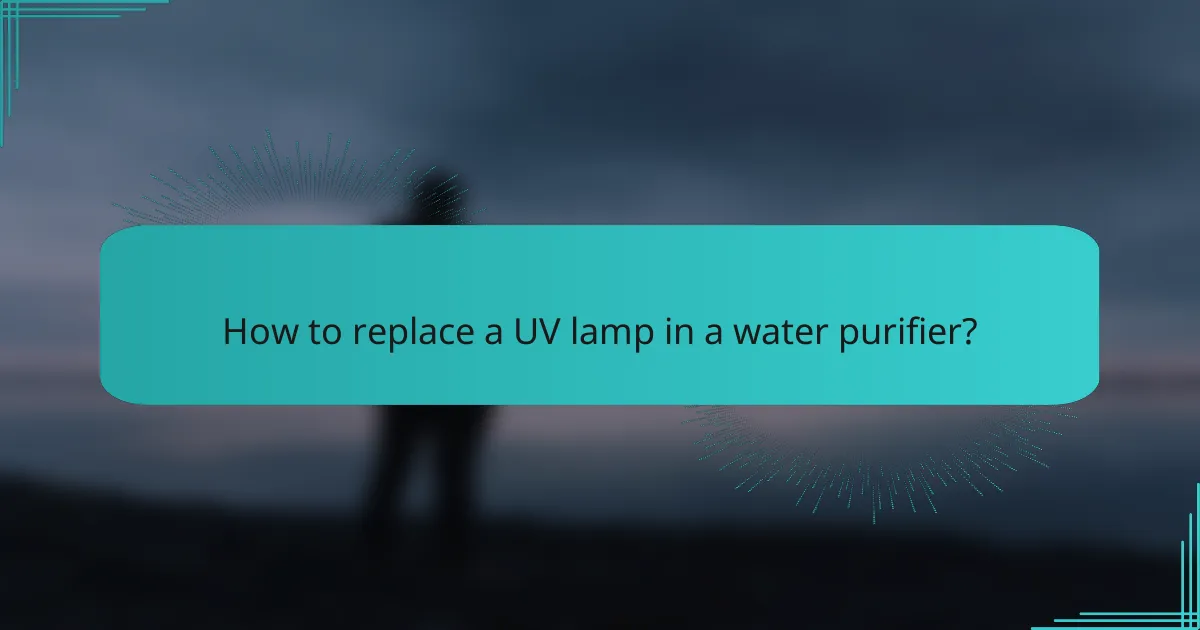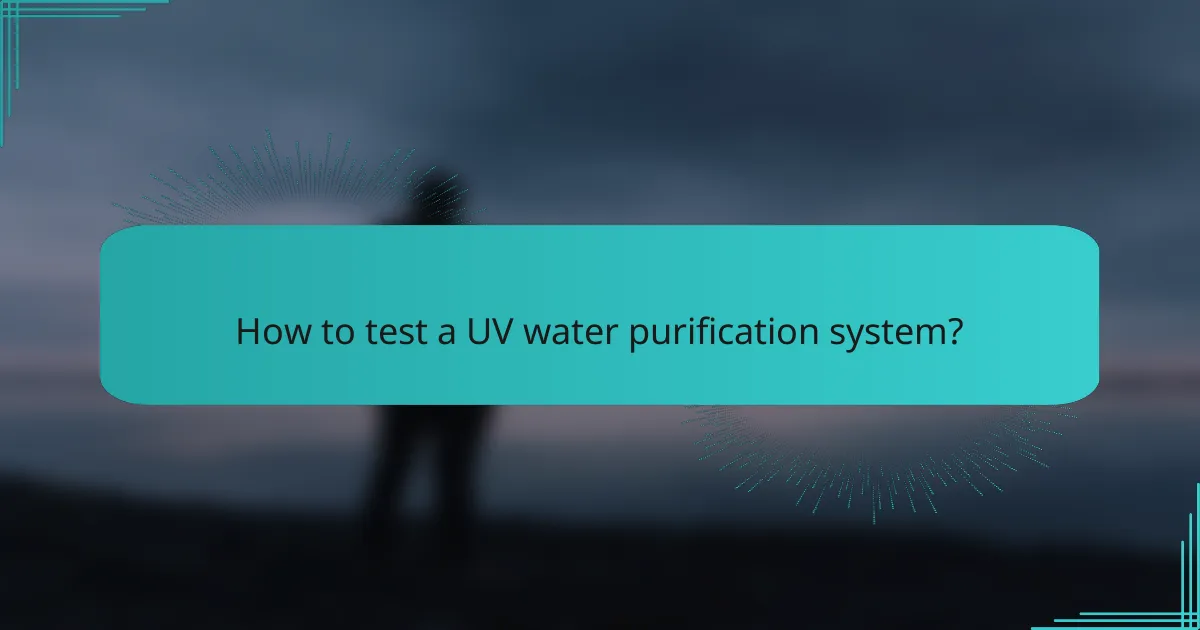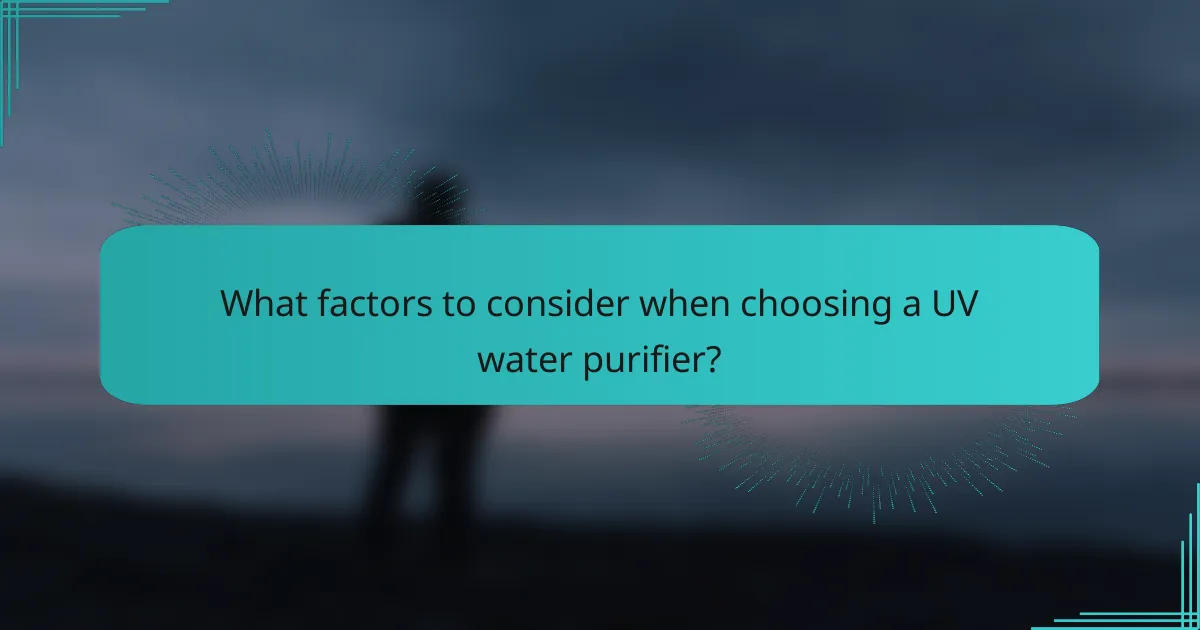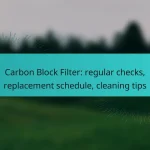Maintaining a UV water purifier involves regular lamp replacement, cleaning the quartz sleeve, and system testing to ensure optimal performance. Replacing the UV lamp every 12 months is crucial for effective disinfection, while cleaning the quartz sleeve prevents mineral buildup that can hinder UV light efficiency. Additionally, routine testing of the system guarantees the elimination of harmful microorganisms, safeguarding water quality.

How to replace a UV lamp in a water purifier?
Replacing a UV lamp in a water purifier is essential for maintaining effective water disinfection. Regular replacement ensures that the lamp operates at optimal intensity, typically every 12 months, depending on usage and manufacturer recommendations.
Step-by-step replacement process
To replace the UV lamp, first, turn off the water purifier and unplug it from the power source. Next, remove the access cover to locate the lamp. Carefully disconnect the old lamp from its socket, ensuring not to touch the glass with bare hands, as oils can reduce its effectiveness.
Install the new lamp by connecting it to the socket and securing it in place. Once installed, replace the access cover, plug the purifier back in, and turn it on. Allow the system to run for a few minutes to ensure proper operation.
Recommended UV lamp brands
When selecting a UV lamp, consider reputable brands known for quality and reliability. Some recommended brands include Philips, Osram, and Aqua Ultraviolet. These brands offer a range of UV lamps compatible with various water purifier models.
Always check compatibility with your specific water purifier model before purchasing. Using a lamp from a trusted brand can help ensure effective water purification and longevity of the system.
Common mistakes to avoid
Avoid touching the glass of the UV lamp with your fingers, as this can lead to reduced efficiency and premature failure. Always use gloves or a cloth when handling the lamp. Additionally, do not skip the replacement schedule; failing to replace the lamp on time can compromise water safety.
Another common mistake is not checking for leaks after replacing the lamp. Ensure all connections are secure and monitor for any signs of water leakage to prevent damage to the purifier or surrounding area.

How to clean the quartz sleeve of a UV water purifier?
Cleaning the quartz sleeve of a UV water purifier is essential for maintaining optimal water purification efficiency. Regular cleaning prevents mineral buildup and ensures that UV light can effectively disinfect water.
Cleaning materials needed
To clean the quartz sleeve, you will need a few basic materials. Gather white vinegar or a mild descaling solution, a soft cloth or sponge, and a pair of gloves for protection. Optionally, you may also want a soft-bristle brush for tougher deposits.
Cleaning process overview
Start by turning off the UV water purifier and disconnecting it from the power source. Carefully remove the quartz sleeve from the unit, ensuring not to damage any components. Soak the sleeve in a solution of vinegar or descaling agent for about 15-30 minutes, then gently scrub with a soft cloth or brush to remove any buildup. Rinse thoroughly with clean water before reassembling.
Frequency of cleaning
The frequency of cleaning the quartz sleeve depends on the water quality and mineral content. For areas with hard water, cleaning every 1-3 months is advisable. In regions with softer water, a cleaning interval of 6 months may suffice. Regular inspections can help determine the need for cleaning based on visible buildup.

How to test a UV water purification system?
Testing a UV water purification system ensures it effectively eliminates harmful microorganisms. Regular checks help maintain water quality and system efficiency.
Testing methods and tools
Common methods for testing a UV water purification system include using UV intensity meters and microbial tests. UV intensity meters measure the output of the UV lamp, while microbial tests assess the presence of bacteria or viruses in the water.
Tools such as a turbidity meter can also be useful, as high turbidity can reduce UV effectiveness. Ensure you have access to reliable testing kits that comply with local standards.
Interpreting test results
When interpreting results, a UV intensity reading below the manufacturer’s specified threshold indicates potential issues with the lamp or system. For microbial tests, the absence of bacteria or viruses confirms effective purification.
Be aware of the acceptable limits for UV intensity and microbial presence according to local regulations. If results are outside these limits, immediate action is necessary to address the problem.
Recommended testing frequency
It is advisable to test a UV water purification system at least once every six months. However, if the system is used heavily or in areas with high contamination risks, quarterly testing may be more appropriate.
Regular maintenance, including lamp replacement and cleaning the quartz sleeve, should coincide with testing to ensure optimal performance. Keeping a log of test results can help track system health over time.

What are the benefits of UV water purification systems?
UV water purification systems offer effective disinfection by using ultraviolet light to eliminate harmful microorganisms. They provide a reliable and chemical-free method for ensuring safe drinking water.
Health benefits
One of the primary health benefits of UV water purification is its ability to destroy bacteria, viruses, and protozoa without introducing harmful chemicals. This method reduces the risk of waterborne diseases, making it particularly important in areas with limited access to clean water.
UV systems can effectively inactivate pathogens such as E. coli and Giardia, ensuring that the water you consume is safe. Regular maintenance, including lamp replacement and cleaning the quartz sleeve, helps maintain these health benefits.
Environmental advantages
UV water purification is environmentally friendly as it does not produce chemical byproducts, unlike some traditional water treatment methods. This reduces the overall chemical load on the environment and minimizes pollution.
Additionally, UV systems consume less energy compared to other purification technologies, making them a sustainable choice for both residential and commercial applications. By opting for UV purification, users contribute to a greener planet while ensuring safe water.
Cost-effectiveness
UV water purification systems can be cost-effective in the long run due to their low operational costs and minimal maintenance requirements. While the initial investment may vary, the absence of chemical purchases and lower energy consumption can lead to significant savings over time.
Moreover, many UV systems have a long lifespan, with lamps typically needing replacement every 12 to 18 months. This longevity, combined with the reduced risk of health issues, makes UV purification a financially sound choice for many households and businesses.

What are the common issues with UV water purifiers?
Common issues with UV water purifiers include lamp failure, quartz sleeve contamination, and system malfunctions. These problems can affect the efficiency of the purification process, leading to potential health risks if not addressed promptly.
Identifying malfunction signs
Signs of malfunction in UV water purifiers can include a noticeable decrease in water quality, such as changes in taste or odor. Additionally, if the system’s indicator light shows that the UV lamp is not functioning or if the water flow rate is significantly reduced, these may be clear indicators of a problem.
Regular monitoring of the UV lamp’s operational hours is essential, as most lamps have a lifespan of around 9,000 to 12,000 hours. If the lamp has been in use for this duration, it may need replacement regardless of visible signs.
Solutions for common problems
To address lamp failure, replace the UV lamp according to the manufacturer’s guidelines, typically every 12 months. Ensure that you purchase a compatible lamp to maintain optimal performance.
For cleaning the quartz sleeve, turn off the system and carefully remove the sleeve. Use a soft cloth and a gentle cleaning solution to remove any deposits or contaminants, then reassemble the unit. Regular cleaning every few months can prevent buildup that impairs UV light transmission.
Testing the system involves checking the UV intensity using a UV meter, which should be done annually. If the intensity is below recommended levels, consider replacing the lamp or consulting a professional for further inspection.

What factors to consider when choosing a UV water purifier?
When selecting a UV water purifier, consider system capacity, flow rate, and installation requirements. These factors ensure that the purifier meets your household’s water needs and fits your space effectively.
System capacity and flow rate
The system capacity refers to the amount of water the UV purifier can treat in a given time, typically measured in liters per minute (LPM). For average households, a flow rate of 5 to 10 LPM is usually sufficient, depending on daily water usage.
It’s crucial to match the purifier’s capacity with your household’s peak water demand. For instance, if multiple faucets or appliances are used simultaneously, choose a unit with a higher flow rate to avoid interruptions in water supply.
Installation requirements
Installation requirements for UV water purifiers can vary significantly based on the model. Some systems are designed for easy DIY installation, while others may require professional help, particularly if plumbing modifications are necessary.
Before purchasing, assess the available space and ensure that the installation area has access to electricity and proper plumbing. Additionally, check if the unit requires a specific mounting position or orientation for optimal performance.


